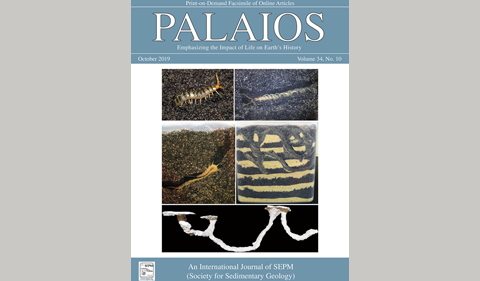
Cover image of the PALAIOS issue showing the burrowing activity and resulting structures of centipedes in the experimental study.
Dr. Daniel Hembree, Professor of Geological Sciences at Ohio University, recently published “Burrows and ichnofabric produced by centipedes: modern and ancient examples” in the journal PALAIOS, published by the Society for Sedimentary Geology. Images from his study were featured on the issue’s cover.
The paper details Hembree’s investigation of the burrowing activity of two living species of centipedes under laboratory conditions. He was interested in understanding how centipedes move and dig through soil, their impact on soil structure, and the morphology of the different traces, such as open burrows, that they produce beneath the surface.
Understanding these aspects of centipede activity is significant because centipedes appear in the fossil record about 420 million years ago, but their fossils are rare due to their lack of easily preserved body parts (such as shells, bones, or teeth). Many centipedes are prolific burrowers, however, and spend their lives moving on and through the soil producing structures that can easily be preserved in the rock record as trace fossils (burrows, tracks, and trails).
The modern burrows Hembree described in the laboratory experiments were compared with fossil burrows found in about 300-million-year-old soils preserved in Athens County, Ohio, which were found to have many similarities. These fossil burrows, therefore, indicate the presence of centipedes within terrestrial ecosystems of the region despite the lack of body fossils of these animals in the ancient soils.
Hembree’s research is focused on understanding the characteristics of structures produced by different types of soil animals through their life activities. These experimental studies are important to improve our understanding of the evolutionary history of animals not normally preserved in the fossil record and the composition of ancient soil ecosystems.




















Comments